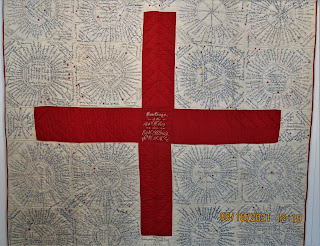First proposed in 1933, it opened to the public in 1967. The Gateway Arch was actually approved by Congress and legislation signed by FDR in 1934. So what took so long? First, the riverfront area of St Louis, which had deteriorated, needed to be acquired and cleared. That took a while and then WW II delayed things. Finally by 1949 a design for the arch had been approved but still another obstacle was the railroad. It took 10 years to approve a plan to move railroad tracks to a tunnel beside the monument area. Bids went out to 50 firms and the winner was 30% above estimates. After the due diligence check, a winner was declared and work began 1961. There were some protests but basically, things proceeded along on course. It was completed in 1967 and opened to the public.
The chief designer, Earo Saarinen described the shape as a catenary curve. Wikipedia quotes him as saying: "This arch is not a true parabola, as is often stated. Instead it is a catenary curve—the curve of a hanging chain—a curve in which the forces of thrust are continuously kept within the center of the legs of the arch." William V. Thayer, a professor of mathematics at St. Louis Community College, later wrote to the St. Louis Post-Dispatch calling attention to the fact that the structure was a weighted catenary.
Normal catenary curve or weighted catenary curve. you decide:
The original shape of the legs was to be square. Although, more sound structurally, aesthetically, a triangle was nicer. So the design changed to equilateral triangles, 54 feet on each side at the base, narrowing to 17 feet each at the top. And the structure is 630 feet high with the legs 630 feet apart.
In the shadow of the arch is the Old Courthouse where Dred and Harriet Scott sued for their freedom. For over 15 years they continually brought cases before the court and although, they occasionally were successful in a lower court, verdicts were always overturned. During this time, they were owned by Irene Emerson. She married Calvin Chafee in 1850. He was elected to Congress in 1854. As an abolitionist Congressman from Massachusetts, this became a sticky issue for him. When the Supreme Court ruled in 1857 that the Scotts did not possess legal standing because they were not US citizens, The Chafees deeded the Scotts to another Congressman, Taylor Blow. He granted them freedom. Dred Scott was employed as a porter at a downtown St Louis hotel when de died about a year and a half later.
Leading through the city to the arch is green space with this wonderful sculpture garden.
Going along the river, south of the arch is an abandoned area trying to make a comeback. This mile long wall was painted with murals but it appears they are being painted over. We didn't encounter anyone else along this walk and were glad to make our way to a more agreeable neighborhood.
\
Killing time, we took a tour of the Field House and Museum. A quilt display caught my eye. Military quilts are not something you normally encounter. The one above is from the Viet Nam War era.
Above, is a WW I era "Red Cross" quilt. These quilts were made to raise money for the war effort. You paid to have your name stitched in. The quilts were often auctioned as well. The red starred names are those who served and yellow stars indicated those who lost their lives in defense of the country.























